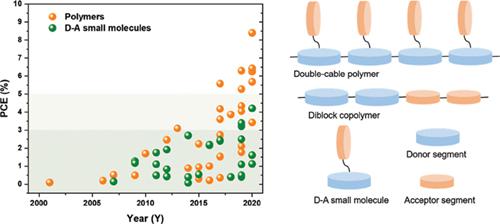Organic Materials Pub Date : 2021-04-26 , DOI: 10.1055/s-0041-1727234 Yakun He 1, 2 , Ning Li 1, 3 , Christoph J. Brabec 1, 3

|
Organic semiconductors with chemically linked donor and acceptor units can realize charge carrier generation, dissociation and transport within one molecular architecture. These covalently bonded chemical structures enable single-component organic solar cells (SCOSCs) most recently to start showing specific advantages over binary or multi-component bulk heterojunction concepts due to simplified device fabrication and a dramatically improved microstructure stability. The organic semiconductors used in SCOSCs can be divided into polymeric materials, that is, double-cable polymers, di-block copolymers as well as donor–acceptor small molecules. The nature of donor and acceptor segments, the length and flexibility of the connecting linker and the resultant nanophase separation morphology are the levers which allow optimizing the photovoltaic performance of SCOSCs. While remaining at 1–2% for over a decade, efficiencies of SCOSCs have recently witnessed significant improvement to over 6% for several materials systems and to a record efficiency of 8.4%. In this mini-review, we summarize the recent progress in developing SCOSCs towards high efficiency and stability, and analyze the potential directions for pushing SCOSCs to the next efficiency milestone.
中文翻译:

具有竞争力的单组分有机太阳能电池
具有化学连接的供体和受体单元的有机半导体可以在一种分子结构内实现电荷载流子的生成,解离和传输。这些共价键合的化学结构使单组分有机太阳能电池(SCOSC)最近由于其简化的器件制造和显着改善的微结构稳定性而开始显示出优于二元或多组分本体异质结概念的特定优势。SCOSC中使用的有机半导体可以分为聚合材料,即双电缆聚合物,二嵌段共聚物以及施主-受主小分子。供体和受体部分的性质,连接接头的长度和柔性以及所产生的纳米相分离形态是可以优化SCOSC光伏性能的杠杆。在过去的十年中,SCOSC的效率一直保持在1-2%的水平,而近来见证了多种材料系统的效率显着提高,达到6%以上,创纪录的效率为8.4%。在此小型审查中,我们总结了在发展SCOSC朝着高效率和稳定性方面的最新进展,并分析了将SCOSC推向下一个效率里程碑的潜在方向。











































 京公网安备 11010802027423号
京公网安备 11010802027423号